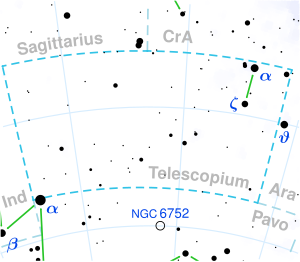格利澤784
外觀
| 觀測資料 曆元 J2000.0 | |
|---|---|
| 星座 | 望遠鏡座 |
| 星官 | |
| 赤經 | 20h 13m 53.396s[1] |
| 赤緯 | -45° 09′ 50.47″[1] |
| 視星等(V) | 7.96[2] |
| 特性 | |
| 光譜分類 | M0V[2] |
| B−V 色指數 | 1.45[2] |
| 天體測定 | |
| 徑向速度 (Rv) | −33.5+0.5 −[1] km/s |
| 自行 (μ) | 赤經:778.331 mas/yr 赤緯:-159.939 mas/yr |
| 視差 (π) | 162.2171 ± 0.0225[1] mas |
| 距離 | 20.106 ± 0.003 ly (6.1646 ± 0.0009 pc) |
| 絕對星等 (MV) | 9.01[3] |
| 詳細資料 | |
| 質量 | 0.58[4] M☉ |
| 半徑 | 0.58[5] R☉ |
| 亮度 | 0.06[5] L☉ |
| 溫度 | 3,754+92 −[6] K |
| 金屬量 [Fe/H] | −0.07+0.06 −[6] dex |
| 自轉 | 48+12 −[7] |
| 自轉速度 (v sin i) | 1.0[2] km/s |
| 年齡 | 0.85+0.4 −[8] Gyr |
| 其他命名 | |
| 參考資料庫 | |
| SIMBAD | 資料 |
格利澤784 是一顆位於望遠鏡座的紅矮星[8],可能擁有一顆系外行星伴星。這顆恆星發出的光線太微弱,肉眼無法看到,視星等為 7.96。[2] 根據視差確定格利澤784距離太陽20.1光年,並以 −33.5 km/s 的徑向速度漂移得更近。[1]預計該恆星系統將在約121,700年的時間內接近到11.4光年處。[10]
這是一顆小型M型主序星,恆星分類為M0V。[2]它比太陽年輕得多,年齡為約0.85億年。[8]儘管如此,它的自轉周期大約48天。[7]這顆恆星的質量是太陽的58%,半徑是太陽的58%。它從其光球層輻射的光度僅為太陽光度的6%[6]。
參考
[編輯]- ^ 1.0 1.1 1.2 1.3 1.4 Brown, A. G. A.; et al. Gaia Early Data Release 3: Summary of the contents and survey properties. Astronomy & Astrophysics. 2021, 649: A1. Bibcode:2021A&A...649A...1G. S2CID 227254300. arXiv:2012.01533
 . doi:10.1051/0004-6361/202039657
. doi:10.1051/0004-6361/202039657  . 已忽略未知參數
. 已忽略未知參數|collaboration=(幫助) (勘誤: doi:10.1051/0004-6361/202039657e). Gaia EDR3 record for this source at VizieR. - ^ 2.0 2.1 2.2 2.3 2.4 2.5 Torres, C. A. O.; et al. Search for associations containing young stars (SACY). I. Sample and searching method. Astronomy and Astrophysics. December 2006, 460 (3): 695–708. Bibcode:2006A&A...460..695T. S2CID 16080025. arXiv:astro-ph/0609258
 . doi:10.1051/0004-6361:20065602.
. doi:10.1051/0004-6361:20065602.
- ^ Anderson, E.; Francis, Ch. XHIP: An extended hipparcos compilation. Astronomy Letters. 2012, 38 (5): 331. Bibcode:2012AstL...38..331A. S2CID 119257644. arXiv:1108.4971
 . doi:10.1134/S1063773712050015.
. doi:10.1134/S1063773712050015.
- ^ The One Hundred Nearest Star Systems. RECONS. Research Consortium On Nearby Stars. January 1, 2012 [2023-03-22]. (原始內容存檔於2012-03-26).
- ^ 5.0 5.1 Gáspár, András; et al. The Correlation between Metallicity and Debris Disk Mass. The Astrophysical Journal. 2016, 826 (2): 171. Bibcode:2016ApJ...826..171G. S2CID 119241004. arXiv:1604.07403
 . doi:10.3847/0004-637X/826/2/171.
. doi:10.3847/0004-637X/826/2/171.
- ^ 6.0 6.1 6.2 Hojjatpanah, S.; et al. Catalog for the ESPRESSO blind radial velocity exoplanet survey. Astronomy & Astrophysics. 2019, 629: A80. Bibcode:2019A&A...629A..80H. S2CID 199552090. arXiv:1908.04627
 . doi:10.1051/0004-6361/201834729.
. doi:10.1051/0004-6361/201834729.
- ^ 7.0 7.1 Byrne, P. B.; Doyle, J. G. Activity in late-type dwarfs. III. Chromospheric and transition region line fluxes for two dM stars. Astronomy and Astrophysics. January 1989, 208: 159–165. Bibcode:1989A&A...208..159B.
- ^ 8.0 8.1 8.2 Brems, Stefan S.; et al, Radial-velocity jitter of stars as a function of observational timescale and stellar age, Astronomy & Astrophysics, 2019, 632: A37, Bibcode:2019A&A...632A..37B, S2CID 204838030, arXiv:1910.10389
 , doi:10.1051/0004-6361/201935520
, doi:10.1051/0004-6361/201935520
- ^ HD 191849. SIMBAD. 斯特拉斯堡天文資料中心.
- ^ Bailer-Jones, C.A.L.; et al. New stellar encounters discovered in the second Gaia data release. Astronomy & Astrophysics. 2018, 616: A37. Bibcode:2018A&A...616A..37B. S2CID 56269929. arXiv:1805.07581
 . doi:10.1051/0004-6361/201833456.
. doi:10.1051/0004-6361/201833456.

